You are, naturally, confused. You are going to see The Hobbit: An Unexpected Journey expecting to see something akin to The Lord of the Rings films.
Think again.
While there are connections between the two trilogies—many of them intentional—the tales spring from vastly dissimilar places. They have as much in common as The Empire Strikes Back and The Phantom Menace. Meaning: almost nothing beyond surface-level noise.
They are films that take place in the same world, sure, but that’s substantially it. The Dirty Dozen and Schindler’s List also take place in the same world—but we would not compare them unless we were drunk and really wanted to ruin our otherwise romantic evening with Telly Savalas.
The film we should obviously compare The Hobbit to is, in fact, The Adventures of Tintin.
Both films were made primarily for children (and parents, and man-children). They both stem from well-known existing source material. Both films are also the first parts of trilogies being overseen by Peter Jackson.
Jackson is godfather to and inheritor of directorial duties on The Hobbit. In the case of Tintin, Spielberg directed it, but Peter Jackson produced and remained heavily involved throughout filming. (Jackson and Spielberg are switching roles for the second Tintin film, which will shoot just as soon as Jackson can wash the orc-stink off his clothes).

So yes. Tintin and The Hobbit. Two valiant competitors for the minds and hearts of our children. How do they compare? Which is the better film? Who will win this Mind Control Film Battle?
I am glad you asked.
May the best gold-seeking, pipsqueak, happenstance adventurer win.
Round 1: Source Material
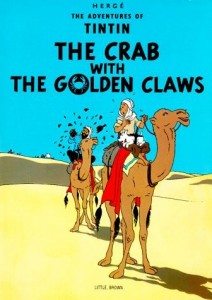 Both films are based on existing work. In the case of Tintin, that’s Hergé’s graphic novels, The Crab with the Golden Claws, The Secret of the Unicorn, and Red Rackham’s Treasure.
Both films are based on existing work. In the case of Tintin, that’s Hergé’s graphic novels, The Crab with the Golden Claws, The Secret of the Unicorn, and Red Rackham’s Treasure.
The Hobbit is based, surprise, not on The Hobbit, but on Peter Jackson’s desire to suck every last footnote out of J.R.R. Tolkien’s legacy. We will give him the benefit of the doubt and assume he does this as he loves Tolkien, and not because he loves taking our money. (Although, granted, both are nice.)
Both scripts appear to have substantially misjudged how much source material would be appropriate for a kids’ film.
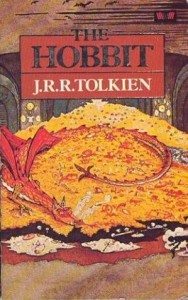 The Hobbit took a trim children’s story, intertwined it with asides and arcana that only serious Ringwraiths cared about, mixed in some LOTR ju-ju sourced from thin air, and then cut the resulting gluggy porridge into thirds. One short kids’ book somehow became an epic peppered with adult content and allusions to films kids won’t have seen. Presumably, this is so The Hobbit films will flow into LOTR.
The Hobbit took a trim children’s story, intertwined it with asides and arcana that only serious Ringwraiths cared about, mixed in some LOTR ju-ju sourced from thin air, and then cut the resulting gluggy porridge into thirds. One short kids’ book somehow became an epic peppered with adult content and allusions to films kids won’t have seen. Presumably, this is so The Hobbit films will flow into LOTR.
That’s kind of like putting real teeth in boxes of Count Chocula. You know. For the kids.
Tintin takes three graphic novels with more-or-less contiguous story lines, tosses a ton of stuff out the window, and knits the remainder into a breakneck, dense film of 107 minutes. It’s all kid-friendly material—assuming alcoholism and murder are kid-friendly—but man do they crunch a lot in there.
In terms of fidelity to the source material, I have to be honest. I don’t care. If I wanted something true to the source material, I would go read the source material. On paper.
These films are both adaptations. That means it is the job of the filmmakers—if they are not complete morons—to prioritize making a watchable, enjoyable, cinematic film. This holds particularly true since we’re talking about kids’ films.
I’m not sure I’m qualified to judge this one, so I’ll put it to the audience. Anyone who has kids who have read the appendices to The Return of the King and really wanted to see that on the big screen, raise your hands. Anyone? Hm. What about parents whose kids have read all of Tintin and can fill in some blanks with their imaginations?
That’s point to Tintin, which clearly left a lot of stuff out, even as it stuffed a lot of stuff in. And a point for me for using a variation of the word “stuff” three times in one sentence.
Round 2: Plot
What’s the story here?
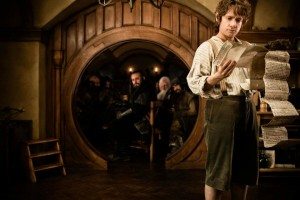
Wow. This script IS long.
In The Hobbit, we start with some stage-setting Frodo/Bilbo stuff that could not be more irrelevant to kids who haven’t seen LOTR. It was also pretty pointless for anyone who had.
Then we get to know our hero, Bilbo Baggins, and see him inundated with dwarves who have survived dragon warfare. That’s good! Dwarves and dragons are good kids’ story stuff. We get assigned a quest and find the courage to accept it. This first how-ever-long section is a bit endless, but there are wizards and singing and hidey-holes and goofy looking moustaches.
Point The Hobbit.
After this, we get on a roundabout in which the dwarven party takes two steps forward, has a battle of some kind, gets pushed one step back, and then starts all over again. If memory serves, they fight trolls, then orcs, then meddling elves, then storm monsters, then goblins (and gollum), then more orcs. None of these battles seem to have anything to do directly with the plot. They’re just obstacles.
Then, some really passive-aggressive eagles fly them most of the way to where they’re going and leave them on a spar of rock for some bromance.
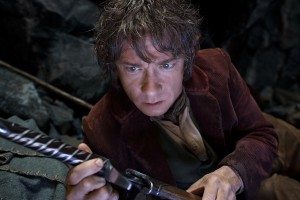 Bilbo finds a magic ring (or, really, he steals it). Sauruman tells Gandalf to go to his room but Gandy asks his mom and she lets him out. There’s also some stuff with Radagast that’s obviously set-up for something that comes in a later film, as it has absolutely nothing to do with the plot of this one.
Bilbo finds a magic ring (or, really, he steals it). Sauruman tells Gandalf to go to his room but Gandy asks his mom and she lets him out. There’s also some stuff with Radagast that’s obviously set-up for something that comes in a later film, as it has absolutely nothing to do with the plot of this one.
Ergo, here’s the plot summary for The Hobbit: An Unexpected Journey:
Bilbo goes adventuring with some homeless dwarves, during which he discovers courage within himself and gains acceptance from the head dwarf.
For a kids’ film, that’s pretty dull, no matter how many action scenes you’ve dressed it up with.
Minus point The Hobbit.
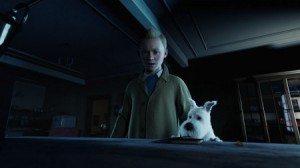
I know I left that ship around here somewhere
In Tintin, the plot is damned intricate for a kids’ film. Tintin, a journalist of some renown despite his youth, buys a model ship that holds the secret to a lost treasure. He struggles with thieves and murderers, gets kidnapped, befriends an alcoholic sea captain, escapes to sea, steals a plane he doesn’t know how to fly, crashes in the desert, attempts to foil the robbery of sheik to be accomplished using an opera singer and a trained hawk (point for originality, minus point for plausibility), out-runs a torrent of water, and eventually claims the McGuffiny pieces of paper he’s been chasing following a prolonged wharf-crane battle.
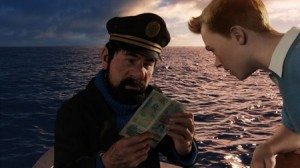 Then Tintin and Captain Haddock find some of the lost treasure and a clue to where they can find the rest.
Then Tintin and Captain Haddock find some of the lost treasure and a clue to where they can find the rest.
I have not mentioned the extensive pirate flashback, the nice pickpocket, the pair of bumbling detectives, or the French Foreign Legion. It was, as I said, a complex story.
Like in The Hobbit, our heros faced hurdle after hurdle on their way towards their objective. All those hurdles actually had something to do with the plot, however.
So the summary for The Adventures of Tintin might be:
A journalist stumbles upon mysterious clues leading to a long-lost treasure and must battle against the descendant of a pirate to reunite the wealth with its proper heir.
Hmm. It certainly sounds like Tintin did a better job of offering up a complete, stand-alone story with a beginning, middle, and end.
Point Tintin.
Round 3: Character
Let’s get to know each other shall we? First round is on me.
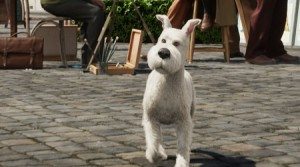
In Tintin, our titular plucky hero isn’t too deeply developed. He’s a journalist with a penchant for getting into trouble and coming out on top. He’s nosy and unafraid. He appears to be about 17. He’s good with firearms and can fly a plane instinctively. Never had one lesson! He would be pretty much lost without his dog, Snowy.
While Tintin’s motivation in the film is at first just curiosity, by the end tenacity, the appeal of overcoming villainy, and the promise of earning a payout all played a part. He didn’t know what he was seeking initially, but it made more sense for Tintin to press on as things progressed.
Then there’s Snowy the dog. He does not look like any dog I’ve ever seen, but who are you going to believe? He appears to have a college-level intelligence. He likes sandwiches and is very good at finding holes in brick walls.
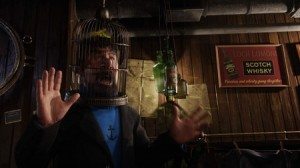
Next, Captain Haddock. He drinks a lot. He can start gasoline engines with his breath. He is fairly useless unless he’s sober except then he’s fairly useless unless he’s drunk. Although he’s not the main character, it’s his treasure we’re hunting for, his self-loathing we’re empathetic to, and his lines and actions that are the funniest.
I understand why Haddock does the things he does in Tintin. His actions are character driven and that’s a pleasant surprise.
The villain, Sakharine is the descendant of the pirate Red Rackham, who stole the Haddock treasure to begin with. Sakharine is a bad man who knows the things Rackham would have told him had he not died before telling anyone. Maybe Rackham sent a Tweet before he drowned? Sakharine thinks using an opera singer to break glass is a good plan.
I can’t say I’m impressed here. Everyone’s pretty sketchy, in the charcoal-drawing sense of the word, with the exception of Haddock, who’s basically an amusingly bumbling alcoholic. In a kids’ film.
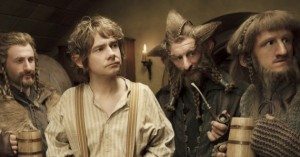 Now let’s look at The Hobbit. There’s Bilbo. There are a metric fuckton of dwarves, all of whom seem to go to the worst barber on the planet. There are a trio of wizards who so rarely do magic it’s not clear why they call themselves wizards. There are some elves, who may be main characters or who may not. There is a one-armed orc-lord and a dragon and a goblin king and gribbley thing named Gollum.
Now let’s look at The Hobbit. There’s Bilbo. There are a metric fuckton of dwarves, all of whom seem to go to the worst barber on the planet. There are a trio of wizards who so rarely do magic it’s not clear why they call themselves wizards. There are some elves, who may be main characters or who may not. There is a one-armed orc-lord and a dragon and a goblin king and gribbley thing named Gollum.
Without calling upon my prior knowledge of these characters, it’s hard to say what we’re shown in just this particular film. (A film, I will remind you, made for children who have not seen LOTR.)
Bilbo, to a degree, is fleshed out. He’s a homebody who adjusts to life on the road and finds a reservoir of courage within himself. I’m not really clear on why Bilbo joins the dwarves or what he wants. Gold? Adventure? How old is Bilbo? Does he have a job? Any friends? No idea. All I know is that he was a rascal as a kid, however long ago that was.
Thorin, the head dwarf, has a comprehensible backstory. He’s bitter and driven and judgmental but he can also admit when he’s wrong. Gandalf seems to only talk about things that happen in another movie. As do the other two wizards and the elves. It is not clear to me why any of them care a whit whether Thorin accomplishes his goal or not. Maybe they bought heavy in dwarf gold before the crash? Can’t say.
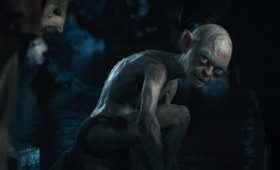 Gollum, who we see in only one scene, is surprisingly well realized. Exactly who and what he is is not made clear, but his personality is undeniable. His wants (to eat Bilbo, to recover his ring) are obvious, as is his misery at not achieving either goal. The other villains are just basically villains. The orc-lord I guess hates Thorin for chopping off his arm decades ago. He seems to be doing just fine without it, though.
Gollum, who we see in only one scene, is surprisingly well realized. Exactly who and what he is is not made clear, but his personality is undeniable. His wants (to eat Bilbo, to recover his ring) are obvious, as is his misery at not achieving either goal. The other villains are just basically villains. The orc-lord I guess hates Thorin for chopping off his arm decades ago. He seems to be doing just fine without it, though.
In short, each film had exactly one character that made real sense and was worth caring about to any degree.
Two points for Andy Serkis.
Round 4: Visuals
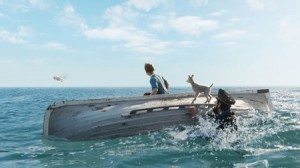 Tintin is an animated motion-capture film. I watched it on my computer monitor—too lazy to move to the living room as I figured I’d only watch half an hour of it before I gave up. The Netflix stream had a weird judder to it and I had to start and stop a few times before it went away. Given this, I thought Tintin looked pretty stellar. The landscapes were creatively realized, action sequences were inventive and engaging, and the people all looked like they were made of marshmallows that had been left out in the sun. Welcome to uncanny valley. Enjoy your stay.
Tintin is an animated motion-capture film. I watched it on my computer monitor—too lazy to move to the living room as I figured I’d only watch half an hour of it before I gave up. The Netflix stream had a weird judder to it and I had to start and stop a few times before it went away. Given this, I thought Tintin looked pretty stellar. The landscapes were creatively realized, action sequences were inventive and engaging, and the people all looked like they were made of marshmallows that had been left out in the sun. Welcome to uncanny valley. Enjoy your stay.
Snowy—who looked cartoony in the graphic novels—looked cartoony in the movie and yet totally unlike Snowy. Grrr. (Minus point Tintin.) There was some great stuff with fire and color and waves and sand, though. Except for the faces, I thought Tintin looked great. Not quite Rango great, but even streaming it, I was impressed.
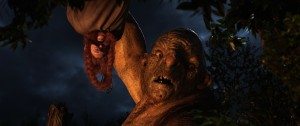
Does this look more or less real than Tintin?
The Hobbit I saw in HFR 3D at the cinema. I thought I’d get used to the hyper-clarity of 48 frames-per-second, but I didn’t. The lighting was all wrong. Nothing looked real nor did it look like a fantasy. Everything looked like real people pretending to be in a fantasy. Oddly, the technology that was advertised as making movies look real instead made what had previously looked real look fabricated.
The CGI monsters all looked super-CGI. The props all looked like props. For example, when Gandalf unwraps the Morgul blade Radagast brought back from Dol Guldur, it looked like it was wrapped in a chamois he found in the back of his ’74 Gremlin. When Thorin’s party charges around goblinville playing hide the javelin, there is never any doubt in anyone’s mind that what they are watching is 100% grade-A unreality.
Point Tintin.
Round 5: Satisfaction
While we can talk about the elements of a film separately, in the end it’s the whole that matters. Does it transport us? Does it make us think? Are we entertained? Would we tell people to see it?
Part of that, whether we want to admit it or not, depends on our expectations.
I bought my tickets to The Hobbit well in advance of opening night. I pretty much loved the Lord of the Rings films—not because I’m any huge fan of the books, but because they were grand adventures done well. When I saw that The Hobbit was getting mixed reviews, I down-graded my expectations. I hoped, as I said to the Supreme Being before it started, that I liked half an hour of it at least.
I didn’t. When I wasn’t bored, I was irritated. There was nothing new about The Hobbit except for the HFR, which I felt was, to be generous, unripe. Everything else felt like a duller, shoddier, less-engaging Fellowship of the Ring—a film you would have had to have seen to appreciate this one at all. And let’s be fair. When I saw The Two Towers and The Return of the King I didn’t feel that way. Although those films took place in the same world, I felt there was newness in them. Visual marvels, great production design, emotion, and character.
I was at no point engaged with The Hobbit. I felt empathy for the characters rarely. Thrice, in fact. Once when the dwarves sang their sad song, once when Bilbo was finally accepted by Thorin (and hated myself for being so easily manipulated), and once for Gollum in his misery.
Satisfaction was very low.
When I decided to watch Tintin, it was because I felt like doing something non-taxing. I didn’t expect to like it, or even to finish watching it. As the evening drew on, and it got later, I grew eager for it to end. I didn’t much care what happened to Tintin and Captain Haddock since the conclusion was foregone. And yet, at times, I stopped and watched close, impressed by how scenes played out, or how the world was imagined. I got surprised by what happened next more than a few times. There was some Raiders of the Lost Ark there, in exuberant moments of grand adventure.
Even though I cared little for the characters, Tintin engaged me on occasion. Surprisingly, I was glad to have watched it.
Point Tintin.
So there you have it. Skip The Hobbit. The best things about it are accomplished more satisfyingly by The Adventures of Tintin. You even get way more Andy Serkis. If you need to go back to Middle Earth, you’ll be happier re-watching The Lord of the Rings. If you want to share Middle Earth with your kids, read them The Hobbit. They’ll remember that experience. The film is forgettable.
Grand tally:
Tintin: 3 points
Andy Serkis: 2 points
Evil Genius: 1 point
The Hobbit: 0 points
